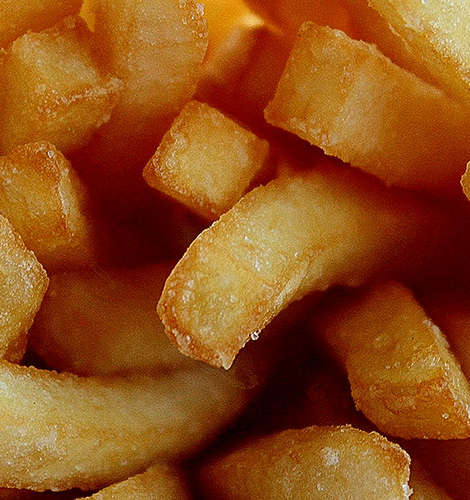What happens when foods are fried
The texture and flavour imparted to food by frying has made this cooking method popular worldwide. Many foods that are fried, but not all, will absorb the oil or fat being used resulting in an increase in the caloric content of the food.
Some oils are more readily absorbed than others and in general, plant foods (e.g. mushrooms, eggplant, potatoes) absorb more fats than meats. In addition, the method of frying, i.e. pan-fried or deep-fried, affects both the absorption of the oil or fat as well as some nutritional properties of the food.
As a result of frying, chemical changes to the oil or fat occur that can result in a decrease in unsaturated fats and the production of trans-fats. These changes are intensified each time the oil is reused.
How fried foods may be bad for your heart
Studies have shown that frequent consumption of fried foods increases the risk for overweight and obesity, and lowers the good high density lipoprotein cholesterol. These, and the trans-fats produced during frying, are all risk factors for cardiovascular disease.
However, only a few epidermological studies have directly evaluated the consumption of fried foods and the risk of cardiovascular disease, and the results have not been consistent.
A study in Costa Rica, where frying is the most common method of food preparation, compared the diets of 485 individuals who had survived an acute myocardial infarction (heart attack) with a control group of 508 subjects. It concludes that fried foods (fried mainly in palm or partially hydrogenated soy oils) were not associated with an increased risk for myocardial infarction.
On the other hand, the INTERHEART study, which assessed the risk of acute myocardial infarction in 52 countries, compared the dietary patterns of 5,761 affected individuals and 10,646 control participants. It concluded that frequent consumption of fried foods was associated with a slightly increased risk for acute myocardial infarction. However, this study did not examine the types of oils or fats used for frying.
Recent study and direct association
A more recent study, which was part of the European Prospective Investigation into Cancer and Nutrition, examined the possible direct association between fried foods and coronary heart disease in a Spanish population. It followed the incidence of coronary heart disease in 40,757 adults who at the start of the study were free of the disease. These individuals entered the study between 1992 and 1996 and were followed up until 2004.
The participants in this study were purposely selected from different regions of Spain to maximize the differences in dietary patterns between north and south, coastal and inland, rural and urban populations. At the start of the study each participant filled out a detailed questionnaire that was used to determine the amounts, types, and method of preparation of foods they consumed, and other characteristics of the individuals.
Of 662 different foods reported by participants, 212 were fried. On average, 138 grams of fried food were consumed daily with a range from 0 to 817 grams per day. About 7% of all food consumed was fried and 62% of the participants used olive oil while the rest used sunflower or other vegetable oils. Men consumed more fried foods per day than women. The study participants were followed up for a median of 11 years, during which time there were 606 coronary disease events and 1,135 deaths from all causes.
When the incidence of heart disease in individuals who had the lowest rate of fried food consumption was compared to that of individuals with the highest consumption, no significant difference was found. This was true whether the oil used for frying was olive oil or sunflower oil. The data also show that there was no association between fried food consumption and all-cause mortality.
The authors of the report point out that there are some limitations to their study. While they carefully assessed the level of fried food consumption and other dietary practices of each individual at the onset of the study, such information was not collected at other points during the 11 year study period. Thus any major or minor changes in dietary patterns would not have been included in the analysis.
Another factor that was not considered was the mode of frying - whether pan-frying or deep-frying was used and the frequency of each type. Each mode affects food differently and the absence of this information might have affected the results.
It is also not known to what extent, if any, other foods in the diet might have offset any adverse effects of frying. For example, a fried food favoured by the Spanish is fish rich in omega 3 fatty acids that have cardioprotective effect. Finally, it is possible that a level of consumption of fried food higher than the highest one in this study can have adverse effects on cardiovascular health.
Conclusion of this study
Despite these cautions about the result of their study, the authors conclude that fried foods are not associated with cardiovascular disease when fried in olive oil that has not been used many times, and when eaten as part of a Mediterranean diet (with lots of vegetables and olive oils).
It seems that fried foods are not total villains some have cast them as …..but, it is wise to take to heart what some other Mediterraneans, the Greeks, advised centuries ago: everything in moderation.





